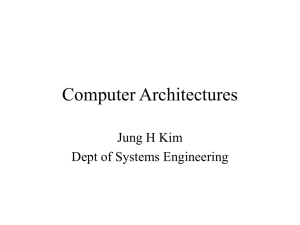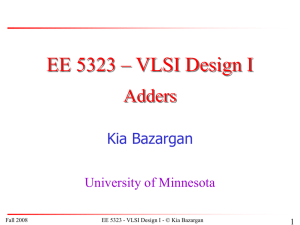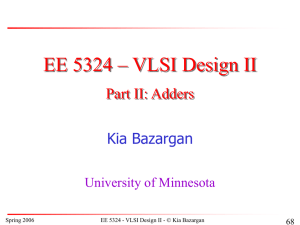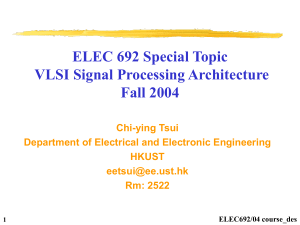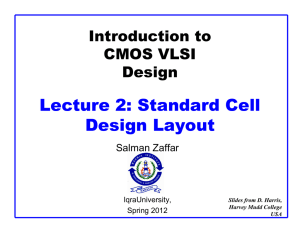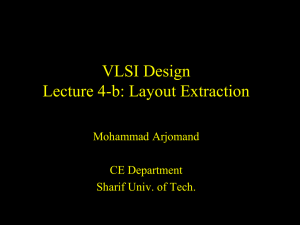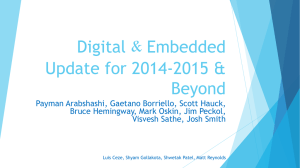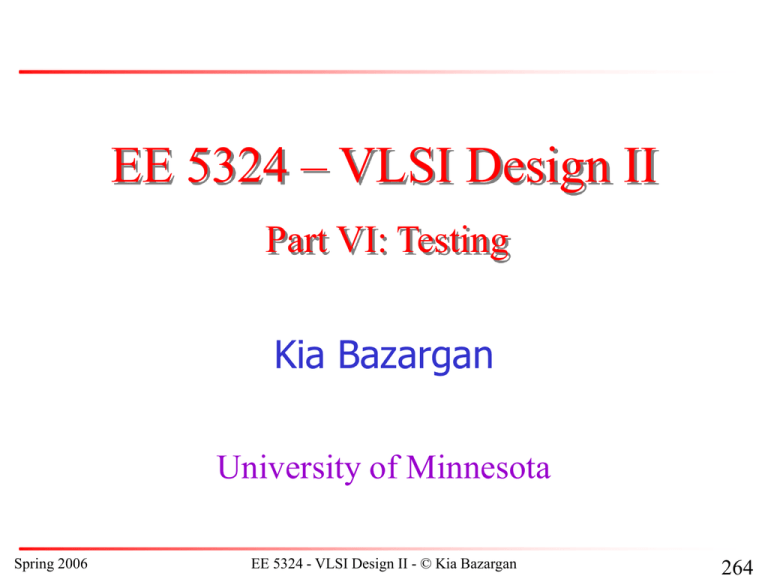
EE 5324 – VLSI Design II
Part VI: Testing
Kia Bazargan
University of Minnesota
Spring 2006
EE 5324 - VLSI Design II - © Kia Bazargan
264
Why Testing?
• If you don’t test it, it won’t work! (guaranteed)
[WE992]
• Intel’s Pentium division bug (’94-’95)
• Intel’s top ten slogans for Pentium: [ Oxford]
9.999997325
8.999916336
7.999941461
6.999983153
It’s a FLAW, dammit, not a bug
Redefining the PC – and math
Nearly 300 correct opcodes
Why do you think it’s called “floating”
point?
. . .
• Taking more and more of design cycle time
• Have to plan for testing when designing
Spring 2006
EE 5324 - VLSI Design II - © Kia Bazargan
265
Testing Categories
• Functionality tests
Done at each level of hierarchy (software+model)
“Is architectural description equivalent to high-level?”
“Is gate-level description equivalent to architectural?”
Higher levels of abstraction faster
Modular design facilitates faster validation
Use diagnostic reasoning to find the bug
• Manufacturing tests
Performed on the final product (wafer or package)
Transistor-level simulation and testing
“Are there any disconnected wires?”
“Any layer-to-layer shorts?”
“Is the product tolerant to Vdd variations?”
Spring 2006
EE 5324 - VLSI Design II - © Kia Bazargan
266
Manufacturing Test Goals
• Make testing fast
• Provide controllability and observability
Controllability: ability to set internal nodes to desired
values
Observability: ability to read internal node values
Challenge:
o Limited number of pins
o Some states might be impossible to generate
• Methods
Provide circuitry to enable test
Provide test patterns that guarantee “reasonable”
coverage (remember Pentium?)
Spring 2006
EE 5324 - VLSI Design II - © Kia Bazargan
267
VLSI vs. Software Testing
• Similarities
Syntax: design rules, electrical rules
Semantics: equivalence of specifications (verification)
Testing: does actual output match expected output
Debugging: similar diagnostic reasoning
• Differences
Not all copies of a chip are identical — defects in
fabrication
Access to internal state in debuggers, breakpoints,
traces
Long turnaround from fabrication increase dependence
on simulation at higher levels
[©Hauck]
Spring 2006
EE 5324 - VLSI Design II - © Kia Bazargan
268
Designing to Reduce Errors
• Layout and electrical rules: don't take chances
(tradeoff density/speed)
• Structured design styles
reduce degrees of freedom and details to handle
• Modular design
Facilitate design changes, faster simulation
• Cell libraries: reuse of existing validated designs
• Timing methodologies: uniform style throughout
system
• Rules of composition: eliminate errors due to
component interconnections
[©Hauck]
Spring 2006
EE 5324 - VLSI Design II - © Kia Bazargan
269
Simulation at All Levels
• Application specific simulators (C)
• High-level / register-transfer-level hardware description
languages for architecture simulation (VHDL, Verilog)
• Logic level for mapping to gates
• Switch level to verify logic structure implementation
• Timing and performance level simulation involving analog
effects (IRSIM)
• Circuit characterization including all analog effects
(SPICE)
• Process simulation to mimic manufacturing process
[©Hauck]
Spring 2006
EE 5324 - VLSI Design II - © Kia Bazargan
270
Product Testing
• Characterization:
Are process params actually within allowable ranges?
Performed by fabrication service
• Acceptance:
Binary decision to keep or throw away
Does chip perform all its functions correctly?
Both by fabrication service (limited)
or designer (more complete)
• Grading:
Grouping of chips into bins corresponding to
performance
Performed by designer
[©Hauck]
Spring 2006
EE 5324 - VLSI Design II - © Kia Bazargan
271
Types of Circuits
• Combinational
2N
inputs required
to exhaustively test
N
Combinational
Logic
K
• Sequential
2M+N inputs required
to exhaustively test
If each test vector
takes 1ms, for M=50
and N=25, need
1 billion years to test!
[WE92]
N
Combinational
Logic
M
K
M
Registers
[WE92]
Spring 2006
EE 5324 - VLSI Design II - © Kia Bazargan
272
Testing Methods
• Stored response:
Pre-stored output vectors
compared to result of input
vector
May need large storage for
complex designs
• Comparison:
Chip under test compared to
known working unit in parallel
Eliminates storage requirements;
easy to modify test
• Algorithmic:
Expected output vectors
computed on the fly by simulator
Most flexible but also slowest
Test
input vectors
Device
Under
Test
(DUT)
Output vectors
[©Hauck]
Spring 2006
EE 5324 - VLSI Design II - © Kia Bazargan
273
Generating and Validating Test Vectors
• Automatic test-pattern generation (ATPG)
For given fault, determine test (aka excitation) vector
that will propagate error to observable output
Most available tools: combinational networks only
• Fault simulation
Determine minimal test vectors that will sensitize
circuit to the fault
Simulates correct network in parallel with faulty
networks
Structure of logic may make some faults untestable
• Both require adequate models of faults in CMOS
integrated circuits
[©Hauck]
[©Prentice Hall]
Spring 2006
EE 5324 - VLSI Design II - © Kia Bazargan
274
Faults
• Hypothesize possible faults for which to test (may
be layout dependent):
Stuck-at-0 (SA0), stuck-at-1 (SA1)
o Node tied to Vdd or GND
Bridging (shorting)
o Two wires tied together on one or more layers
Stuck-open
o Break in a wire disconnects two wires
Delay faults
o Parameter variations slow down a gate
Path-delay faults
o Cumulative delay faults along a path
Multi-fault
o Test for combination of faults not one at a time
Spring 2006
EE 5324 - VLSI Design II - © Kia Bazargan
[©Hauck]
275
Fault Models
• Stuck-at covers most of the faults
Shown: short (a,g), open (b)
x1
x2
Z
a
g
a, g :
b:
x3
x1 sa1
x1 sa0 or
x2 sa0
b
[©Prentice Hall]
Spring 2006
EE 5324 - VLSI Design II - © Kia Bazargan
276
Fault Models (cont.)
• Stuck-at does not cover all faults
Example: Sequential effect:
x2
x1
x1
Z
x2
x1
x2
Z
0
1
1
x
1
0
1
0
Zn-1
Needs two vectors to detect
• Other options:
Use stuck-open or stuck-short models
Problem: too expensive!
[©Prentice Hall]
Spring 2006
EE 5324 - VLSI Design II - © Kia Bazargan
277
Test Vector Generation: First Shot
F in presence of different stuck-at faults
ABC F
Fm0 Fn0
Fp0
Fq0
Fm1 Fn1
Fp1
Fq1
000
001
010
011
100
101
110
111
1
0
1
0
1
0
1
0
1
0
1
0
1
0
1
0
0
0
0
0
0
0
1
1
1
0
1
1
1
0
1
1
1
1
1
1
1
1
1
1
1
1
1
1
1
1
1
1
1
0
1
0
1
0
1
1
1
0
1
0
1
0
1
0
1
0
1
0
1
1
1
1
fault table
ABC m0,n0,p0 q0
000
001
010
011
100
101
110
111
m1
n1
p1,q1
1
1
A
B
m
p
n
1
1
1
1
1
C'
F = AB + C'
1
1
Spring 2006
q
[©Hauck]
EE 5324 - VLSI Design II - © Kia Bazargan
278
Test Vector Generation: Path Sensitization
• Work forward and backward from node of interest to
determine values of inputs to test for fault
• At the site of the fault, assign a logical value
complementary to the fault
• Select a path from the circuit inputs through the site of
the fault to an output, the path is sensitized if the inputs
to the gates along the path are set so as to propagate the
value at the fault site
• Determine the primary inputs that will produce the
required values at the gate inputs as determined above[©Hauck]
Spring 2006
EE 5324 - VLSI Design II - © Kia Bazargan
279
Path Sensitization Example
• Trigger the fault
• Make it propagate to output
Fault enabling
1
1
1
Fault propagation 1
sa0
1
1
Out
0
0
[©Prentice Hall]
Spring 2006
EE 5324 - VLSI Design II - © Kia Bazargan
280
Problems in Combinational Logic Testing
• Untestable faults
Redundant logic (reconvergent fanout) can make some
faults untestable
Is it necessary? (carry-bypass)
• Computationally expensive
To determine minimum number of tests
• Are all paths important?
Some paths may be unsensitizable (false paths)
Input combination may never occur
• Multiple faults
One fault may invalidate test for another
Too expensive to model multiple-faults
Spring 2006
EE 5324 - VLSI Design II - © Kia Bazargan
[©Hauck]
281
Testing Sequential Logic
• Input vector sequence to get circuit into correct
state and then another sequence to get result to
a primary output
• Testing of concealed state-intensive designs is
impossible in practice
• Make some state bits controllable and observable
requiring less depth in sequence of input vectors
• Make all state bits controllable and observable
reducing problem to one of combinational circuit
testing
[©Hauck]
Spring 2006
EE 5324 - VLSI Design II - © Kia Bazargan
282
Level Sensitive Scan Design (LSSD)
• Known as scan-based test
• Scan path (shift register) links all state elements
in circuit
• Observe and control all states
• Requires 3 extra pins and a bit more logic in FFs
• All tests become combinational
• Very slow — shift in test vector and shift out
output vector serially — partial scan
paths only use necessary amount
• Easy to extend to system level
[©Hauck]
Spring 2006
EE 5324 - VLSI Design II - © Kia Bazargan
283
Scan Based Test
ScanIn
ScanOut
Out
Combinational
Logic
A
Register
Register
In
Combinational
Logic
B
[©Prentice Hall]
Spring 2006
EE 5324 - VLSI Design II - © Kia Bazargan
284
Scan Path Register
SCAN
PHI2
PHI1
SCANIN
OUT
SCANOUT
IN
LOAD
KEEP
[©Prentice Hall]
Spring 2006
EE 5324 - VLSI Design II - © Kia Bazargan
285
Scan-Based Test Operation
In0
test
In1
test
test
In2
test
test
In3
test
test
test
Scan In
Latch
Latch
Latch
Latch
Out0
Out1
Out2
Out3
Scan
Out
Test
f1
f2
N cycles scan in
Spring 2006
1 cycle N cycles scan out
evaluation
EE 5324 - VLSI Design II - © Kia Bazargan
[©Prentice Hall]
286
Scan-Based Testing on Pipelined Designs
• Efficient: use the existing registers
A
B
REG[1]
REG[0]
REG[2]
REG[3]
SCANIN
+
REG[4]
COMPIN
COMP
REG[5]
SCANOUT
OUT
Spring 2006
EE 5324 - VLSI Design II - © Kia Bazargan
[©Prentice Hall]
287
Boundary Scan (JTAG)
Printed-circuit board
Logic
Scan-out
si so
scan path
Normal connections
Scan-in
Packaged IC
Bonding Pad
Spring 2006
EE 5324 - VLSI Design II - © Kia Bazargan
[©Prentice Hall]
288
Random Access Scan
• When FFs arranged in memory like structure
(limited class of designs)
• Use decode logic to select FF to observe/control
• Does not require shifting of all state elements —
leads to faster tests
inputs
in
r/w
combinational
logic
addressable
storage
elements
address
Spring 2006
outputs
out
[©Hauck]
EE 5324 - VLSI Design II - © Kia Bazargan
289
Self Testing
• Built-in self test (BIST)
• Chip itself generates test vectors (internally)
Dedicated sub-circuit to generate pseudo-random
test vectors
Use “linear feedback shift register (LFSR)” to generate
test vectors
• Use signature to check the integrity
Apply sequences of input vectors and combine the
output into a signature
• Shift in initial seed and shift out the signature
Spring 2006
EE 5324 - VLSI Design II - © Kia Bazargan
290
Linear-Feedback Shift Register (LFSR)
Spring 2006
R
R
R
S0
S1
S2
1
0
1
1
1
0
0
1
0
1
0
1
1
1
0
0
0
0
1
0
1
1
1
0
EE 5324 - VLSI Design II - © Kia Bazargan
291
BIST: Signature Analysis
• Compress the output vector
Time compression (count # of transitions)
OR: compute output parity vector
• Example: time compression:
In
Counter
R
[©Prentice Hall]
Spring 2006
EE 5324 - VLSI Design II - © Kia Bazargan
292
Built-in Logic Block Observation (BILBO)
D0
B0
D1
D2
B1
ScanIn
R
S0
B0 B1
1
0
1
0
Spring 2006
1
0
0
1
R
S1
ScanOut
R
S2
Operation mode
Normal
Scan
Pattern generation or signature analysis
Reset
[©Prentice Hall]
EE 5324 - VLSI Design II - © Kia Bazargan
293
BILBO – Pattern Generation
D0 =1
B0=1
D1=1
D2 =1
B1=0
ScanIn
R
S0
B0 B1
1 0
Spring 2006
R
S1
ScanOut
R
S2
Operation mode
Pattern generation or signature analysis
EE 5324 - VLSI Design II - © Kia Bazargan
294
BILBO – Pattern Generation vs. Signature Anal
• In addition to the BILBO circuit shown in two
slides ago, you may need some extra logic
(e.g., multiplexers) that send either Di’s or 1’s
• Pattern generation
simple LFSR
• Signature analysis
Complex
But we can simulate and predict the correct values
Spring 2006
EE 5324 - VLSI Design II - © Kia Bazargan
295
BILBO Application
Scan in
Comb
Logic 4
BILBO 5
Comb
Logic 3
BILBO 4
Comb
Logic 2
BILBO 3
Comb
Logic 1
BILBO 2
BILBO 1
in
out
Scan out
• Operation:
Seed sent in using the scan chain
Even BILBOs operate in pattern gen mode, odd ones in
signature analysis
After a complete cycle (or desired # of cycles), odd
BILBO values read through scan out
The same process repeats, this time with even BILBOs
in signature analysis, odd ones in pattern generation
Spring 2006
EE 5324 - VLSI Design II - © Kia Bazargan
296
Memory Self-Test
Data in
Memory
Under Test
FSM
Data out
Signature
Analysis
Address &
R/W Ctrl
Patterns: Writing/Reading 0s, 1s,
Walking 0s, 1s
Galloping 0s, 1s
[©Prentice Hall]
Spring 2006
EE 5324 - VLSI Design II - © Kia Bazargan
297
To Probe Further (Testing)
• BIST
K. A. Ockunzzi and C. Papachristou, "Test Strategies for
BIST at the Algorithmic and Register-Transfer Levels",
Design Automation Conference, pp. 65-70, 2001.
• LFSR
W. G. Solomon, “Shift Register Sequences”, Aegean
Park Press, 1982.
Spring 2006
EE 5324 - VLSI Design II - © Kia Bazargan
298

